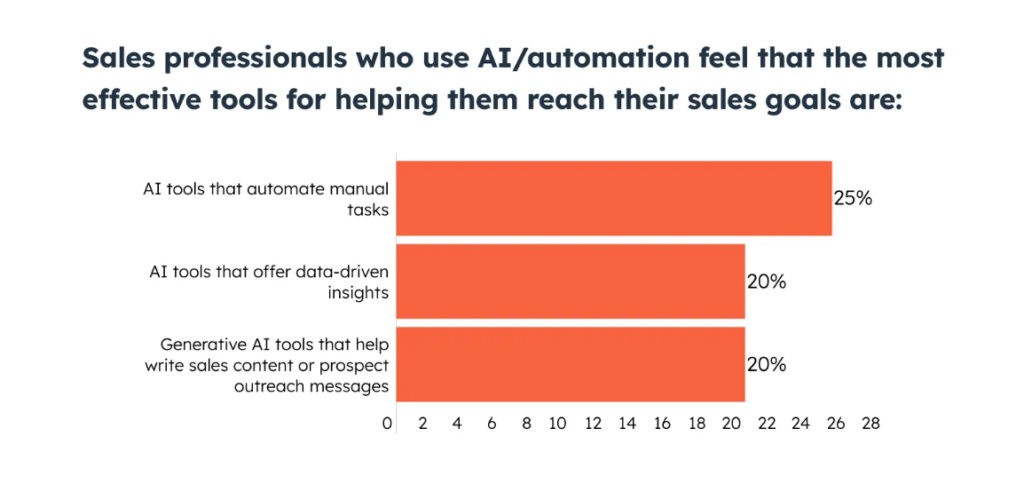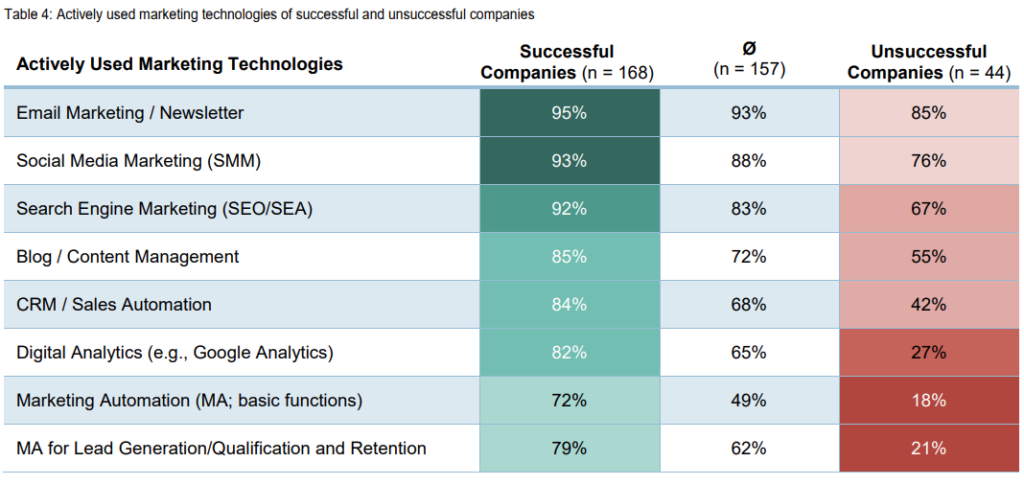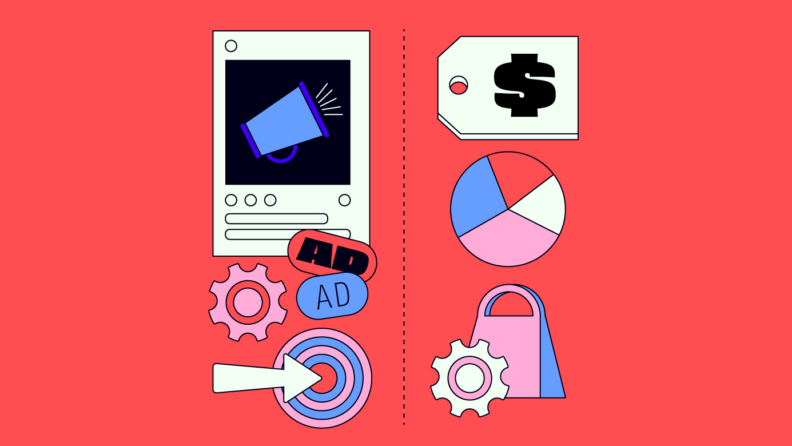The sales automation vs. marketing automation debate is predicated on one B2B sales maxim - time is money. Especially because sales reps often find themselves burdened with tedious, repetitive tasks instead of focusing on what they do best: selling.
Technologies such as sales automation and marketing automation all promise to provide a solution to this problem, allowing sales teams to maximize their selling time. However, distinguishing between these two solutions can be challenging due to their overlapping features and advantages.
Today, we’ll compare sales automation vs. marketing automation and explore the ideal use case for each tool. Come along for a deep dive into sales and marketing automation, their similarities, differences, and key considerations you need to keep in mind when putting together your martech stack.
What is Sales Automation?
Sales automation uses technology to automate repetitive, time-consuming tasks in the sales process. The goal of sales automation is to improve sales efficiency and close rates through automated workflows and enhanced data processing.
Sales automation tools leverage technology to improve sales operations such as:
- Lead management, including capturing, tracking, and nurturing leads.
- Pipeline management, such as monitoring sales pipelines to limit missed opportunities.
- Sales funnel automation, including sales outreach, engagement, follow-up emails, meeting scheduling, and data entry.
- Pricing and resource management, including pricing strategies, quotas, and optimized allocation of resources.
- Sales forecasting, such as advanced data and analytics to predict future sales performance and trends.
Through the use of sales automation your sales team can work smarter, not harder, improving ROI and driving business growth in the process.
Benefits of an Effective Sales Automation Strategy
The primary benefit of sales automation is reducing manual labor and improving data processing, both of which increase productivity and face-time with prospects. Early-adopters of sales automation report sales uplift potential up to 10% and efficiency improvements of 10-15% (McKinsey, 2020).
The full benefits of sales automation include:
- Boosted productivity and efficiency by automating repetitive tasks to save time, reduce manual errors, and free up sales reps to focus on building relationships and closing deals.
- Enhanced lead management and forecasting with the help of automated alerts to sales reps when lead activities occur, such as link clicks, website visits, or email openings.
- Increased lead generation and lead quality through automated outreach efforts and marketing funnel optimization, such as personalized emails, messages, and follow-ups that generate higher-quality leads in less time.
- Enhanced customer relationship management by creating a seamless journey for leads through the sales pipeline, maintaining strong engagement and customer relationships.

Popular examples of sales automation tools include platforms like Salesforce, HubSpot Sales, Pipedrive, and Outfunnel. These sales automation tools help to streamline your sales workflows, improve efficiency, and enhance the overall performance of your sales teams.
What is Marketing Automation?
Marketing automation software uses machine learning algorithms and advanced data processing to improve and measure marketing processes. This enables marketers to increase efficiency, improve lead nurturing, and enhance the impact of their campaigns.
Key features supported by this class of marketing software include:
- Campaign management, such as designing, executing, and monitoring multi-channel marketing campaigns.
- Lead nurturing, such as moving leads through personalized email sequences and targeted content.
- Customer segmentation, including analyzing customer data to identify and target specific audience segments and prioritize market segments.
- Performance analytics, such as tracking and analyzing the performance of your marketing campaigns to optimize future strategies.
Benefits of an Effective Marketing Automation Strategy
Marketing automation tools drive many modern marketing strategies. In fact, companies that consider themselves "successful" prioritize the use of marketing automation and technology more than their less successful counterparts (Zumstein et al., 2021).
The full benefits of implementing marketing automation include:
- Increased efficiency through the automation of repetitive tasks, saving time and reducing manual errors, which allows your team to focus on strategic activities.
- Enhanced customer engagement and personalization by delivering personalized experiences at scale, ensuring each customer receives relevant content and offers tailored to their needs.
- Improved lead management and nurturing processes through automated personalized email sequences and content delivery, effectively guiding leads through their journey and increasing conversion rates.
- Better data and insights for optimizing marketing strategies by gaining detailed analytics on campaign performance and customer behavior, helping you make informed decisions and refine your strategies.
- Higher ROI through streamlined and effective marketing efforts, resulting in more efficient campaigns and improved return on investment.

Popular examples of marketing automation tools include platforms like Adobe Marketo, Omnisend and Mailchimp. Through the use of these tools and software, your marketing teams can improve the reach and impact of their campaigns, driving brand awareness and improving the quality of leads delivered to sales.
Sales Automation vs. Marketing Automation: Differences & Similarities
There’s clear crossover between sales and marketing automation tools, reflecting the essential collaboration needed between sales and marketing to drive significant returns in either arena.
While sales and marketing are inherently linked, there are notable differences to consider for marketing automation vs. sales automation. Understanding the unique role of each tool is essential before investing, and in some cases, a comprehensive tech stack may benefit from including both types of tools.
Let’s explore the key differences and similarities between sales automation and marketing automation in a few core areas:
| Differences | Similarities | ||
| Sales Automation | Marketing Automation | ||
| Responsibility | Manages sales processes and tasks like lead follow-ups and pipeline management. | Manages marketing tasks such as email campaigns and lead nurturing. | Both tools streamline and automate routine tasks to improve efficiency. |
| Goals | Aims to increase sales efficiency, close rates, and overall revenue. | Aims to generate leads, nurture them, and drive engagement. | Both aim to drive better results through improved processes and automation. |
| Key Metrics | Metrics include sales conversion rates, deal velocity, and pipeline growth. | Metrics include lead conversion rates, email open rates, and campaign ROI. | Both rely on data and analytics to measure performance and optimize strategies. |
| Lead Quality | Focuses on qualifying leads and managing them through the sales funnel to close deals. | Focuses on nurturing leads and delivering personalized content to increase lead quality. | Both improve lead management and enhance lead quality through targeted actions. |
| Implementation Stage | Often implemented after initial sales processes are established, focusing on optimizing existing workflows. | Typically implemented during early stages of marketing efforts to build and scale campaigns. | Both require strategic planning and alignment with business goals for successful implementation. |
| Team Productivity | Increases sales team productivity by automating administrative tasks and improving workflow efficiency. | Enhances marketing team productivity by automating campaign management and lead nurturing. | Both tools boost team productivity by automating repetitive tasks and freeing up time for strategic work. |
Sales Automation vs. Marketing Automation: Differences
1. They Prioritize Different Tasks: Sales Operations vs. Marketing Efforts
Sales automation and marketing automation prioritize different tasks within the business workflow. Sales automation focuses on automating sales operations, such as managing lead follow-ups, tracking deals, and pipeline management.
In contrast, marketing automation focuses on automating marketing tasks, such as content creation, social media scheduling, campaign management, and lead generation. This helps marketing teams streamline efforts to attract and engage potential customers.
2. Their Goals Differ: Closed Deals vs. Generated Leads
The goals of sales automation and digital marketing automation also differ. Sales automation aims to close deals and boost sales efficiency by managing and optimizing various aspects of the sales process. It is designed to streamline activities that directly contribute to converting leads into customers.
On the other hand, marketing automation aims to generate leads and build brand awareness. It focuses on creating and managing campaigns that drive interest and capture potential leads at the awareness and interest stage of the customer journey.
3. They Monitor Different KPIs: Sales Success vs. Marketing Impact
In alignment with the tasks they prioritize, marketing and sales automation each monitor a distinct set of metrics and key performance indicators (KPIs). Sales automation tracks metrics related to sales success, such as conversion rates, deal velocity, and pipeline growth.
Marketing automation, however, measures marketing impact through KPIs like lead conversion rates, email open rates, and campaign return on investment (ROI). These metrics help assess the effectiveness of marketing campaigns and strategies.
4. Their Implementation Stage Differs: Sales Funnel vs. Marketing Funnel
Sales and marketing automation are implemented at different stages of the customer journey and sales funnel. Marketing automation comes into play at the top and middle of the sales funnel, where the main goal is to generate brand awareness, interest and qualified leads.
Sales automation can be implemented at any stage of the sales funnel, from prospecting through to lead scoring and closing deals. In short, marketing automation helps with locating and targeting prospects, while sales automation does the heavy lifting to convert prospects into beneficial customer relationships.
Sales Automation vs. Marketing Automation: Similarities
1. Both Enhance the Quality of Leads Entering the Funnel
Both sales automation and marketing automation enhance the quality of leads entering the funnel. Sales automation improves the lead management process by nurturing and qualifying leads through targeted follow-ups and engagement.
Similarly, marketing automation enhances lead quality by delivering personalized content and automating lead nurturing campaigns. Whether working separately or combined, these tools ensure only the most qualified leads move through the funnel, leading to higher conversion rates and better overall sales outcomes.
2. Both Eliminate Repetitive Tasks
Both types of automation eliminate repetitive tasks, freeing up valuable time for team members. Sales automation handles routine tasks such as follow-up emails, meeting scheduling, and data entry, allowing sales reps to focus on more strategic activities.
Marketing automation takes care of repetitive marketing tasks like email campaigns, social media posts, and lead scoring. By automating these routine processes, both tools increase efficiency and allow teams to concentrate on high-value activities.
3. Both Improve Data Processing and Management
Both sales and marketing automation improve data processing and management. Sales automation provides insights into sales performance through detailed data analytics, helping to refine sales strategies and optimize processes.
Marketing automation offers valuable data on campaign performance, customer behavior, and engagement metrics. This enhanced data processing capability enables both sales and marketing teams to make informed decisions, improve their strategies, and ultimately achieve better results.
3 Points To Consider Before Making A Decision
This leads us back to the question: do you need marketing automation, sales automation or both? As you weigh your options, it's important to consider the following key factors:
1. Your Marketing and Sales Goals
What are you aiming to achieve through marketing and sales automation? Evaluating your business needs is the first step to finding the tool that will drive the most impact for your organization.
Take the time to align on core business goals with senior stakeholders, marketing and sales teams. Identify areas of improvement within your marketing operations and sales processes, evaluate available solutions, and highlight your must-have features for marketing and sales automation software.
2. Your Budget
Marketing and sales software come with varying price points and pricing models. Assessing your budget helps you determine what you can afford and find the best solution within your financial constraints.
It also allows you to weigh the cost against potential benefits and ROI. Choose a tool that fits within your budget while offering the features and benefits that align with your goals and delivers the best value.
3. Ease of Implementation
A tool that integrates smoothly with your existing systems and tech stack, while remaining user-friendly, is key for reducing the time and resources required for implementation. It also affects how quickly your team can start using the tool effectively and realize its benefits.
Consider the complexity of implementation, training requirements, and the level of support provided. Opt for a tool with straightforward implementation and high-quality customer support to minimize potential hiccups and ensure a smooth adoption process for your teams.
Do You Need Sales Automation Or Marketing Automation?
When deciding between sales automation and marketing automation, it's crucial to align your choice with your specific business needs and objectives:
- Sales automation is best for businesses aiming to streamline their sales processes, enhance productivity, and close deals more efficiently. It’s ideal for teams needing tools to manage lead follow-ups, track deals, and improve overall sales operations.
- Marketing automation excels in generating leads, managing marketing campaigns, and personalizing customer interactions at scale. It’s suitable for both B2B and B2C markets that need to automate repetitive tasks and enhance their marketing impact.
Your choice should align with your sales and marketing goals, budget, and the ease of implementation. Consult with your teams and stakeholders to ensure you select the solution that best meets your needs and supports your growth strategy.
Join For More MarTech Insights
Stay updated with the latest in sales and marketing technology by subscribing to The CMO Newsletter. Get expert tips and insights straight to your inbox!


